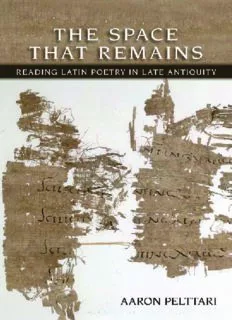
The Space That Remains: Reading Latin Poetry in Late Antiquity PDF
Preview The Space That Remains: Reading Latin Poetry in Late Antiquity
c THE SPACE THAT REMAINS A VOLUME IN THE SERIES Cornell Studies in Classical Philology Edited by Frederick M. Ahl, Theodore R. Brennan, Charles F. Brittain, Michael Fontaine, Kim Haines-Eitzen, David P. Mankin, Sturt W. Manning, Alan J. Nussbaum, Hayden N. Pelliccia, Verity Platt, Pietro Pucci, Hunter R. Rawlings III, Éric Rebillard, Jeffrey S. Rusten, Barry S. Strauss, Michael Weiss A list of titles in this series is available at www.cornellpress.cornell.edu. THE SPACE f THAT REMAINS f READING LATIN POETRY IN LATE ANTIQUITY Aaron Pelttari CORNELL UNIVERSITY PRESS Ithaca and London Copyright © 2014 by Cornell University All rights reserved. Except for brief quotations in a review, this book, or parts thereof, must not be reproduced in any form without permission in writing from the publisher. For information, address Cornell University Press, Sage House, 512 East State Street, Ithaca, New York 14850. First published 2014 by Cornell University Press Printed in the United States of America Library of Congress Cataloging- in- Publication Data Pelttari, Aaron, 1982– author. The space that remains : reading Latin poetry in late antiquity / Aaron Pelttari. pages cm. — (Cornell studies in classical philology) Includes bibliographical references and index. ISBN 978- 0- 8014- 5276- 5 (cloth : alk. paper) 1. Latin poetry– History and criticism. 2. Latin poetry— Appreciation. 3. Authors and readers— Rome. 4. Reader- response criticism. I. Title. PA6051.P45 2014 871'.0109—dc23 2014002762 Cornell University Press strives to use environmentally responsible suppliers and materials to the fullest extent possible in the publishing of its books. Such materials include vegetable- based, low- VOC inks and acid- free papers that are recycled, totally chlorine- free, or partly composed of nonwood fi bers. For further information, visit our website at www .cornellpress .cornell .edu . Cloth printing 10 9 8 7 6 5 4 3 2 1 Jacket art: Verg. Aen. 11, 371–72 repeated on Oxyrhynchus Papyri, vol. 50, 3554. Photo courtesy of the Imaging Papyri Project and the Egypt Exploration Society. For Natalia hanc praetexuit velut in musica concordiam dissonorum he hid it like the harmony of music in dissonance Marcob. Sat. 5.1.18 c Contents Ac know ledg ments ix List of Abbreviations xi Introduction: Late Antique Poetry and the Figure of the Reader 1 1. Text, Interpretation, and Authority 12 2. Prefaces and the Reader’s Approach to the Text 45 3. Open Texts and Layers of Meaning 73 4. The Presence of the Reader: Allusion in Late Antiquity 115 Conclusion 161 References 165 General Index 181 Index of Passages Cited 187 c Ac know ledg ments In these days of tightened budg ets and nar- rowed visions, I have been privileged with the opportunity to explore the history of Latin poetry. I am thankful to Cornell University and to the Uni- versity of California, Santa Barbara, for the support that allowed me to com- plete this book. I am convinced that such studies are vital for a culture that is increasingly ignorant of its past, and it is my earnest hope that the recep- tion of classical literature in late antiquity may show in some small way that the humanities can still have a bright future in our culture today. Learning about the classical world both deepens my understanding of history and broadens my enjoyment of literature. For that I am grateful. I am also glad to acknowledge the personal debts accumulated in writing this book. The incisive reading of Éric Rebillard lies behind most of the structure and clarity that these chapters may have. I have been glad many times for his mentoring and friendship. Michael Fontaine, Joseph Pucci, and Hayden Pelliccia have also improved my work in a great many ways. Pucci is the kindest of readers, and Fontaine has a knack for fi nding just the right detail to adjust. Erik Kenyon, Zachary Yuzwa, and Jeffrey Leon read early drafts of each chapter. Talking over lunch about our writing remains one of my fondest memories of Ithaca. A number of other friends and col- leagues read or discussed with me portions of my work at various stages in the writing of it. In par tic u lar, I am grateful to Kim Bowes, Charles Brittain, Kim Haines- Eitzen, Gavin Kelly, Cillian O ’Hagan, Christopher Polt, Suzanne Rebillard, and Catherine Ware. The anonymous readers for Cornell Uni- versity Press made a number of valuable suggestions. If there w ere space and my memory was better, there are surely many others who have infl uenced me. My notes will give some idea of how much I have learned from the writings of others. If I w ere not so stubborn, I surely would have benefi ted more from all this help. As it is, I alone am responsible for the infelicities and misjudgments that surely are here. My greatest debt is to my wife, who encouraged me to begin, continue, and fi nish this project. I am thankful as well for the patience of both of my ix
Description: